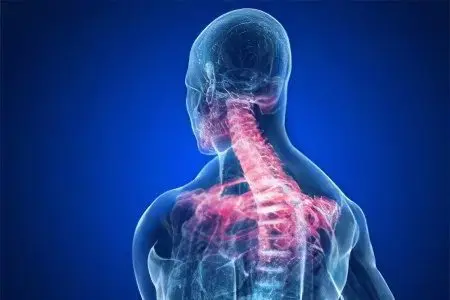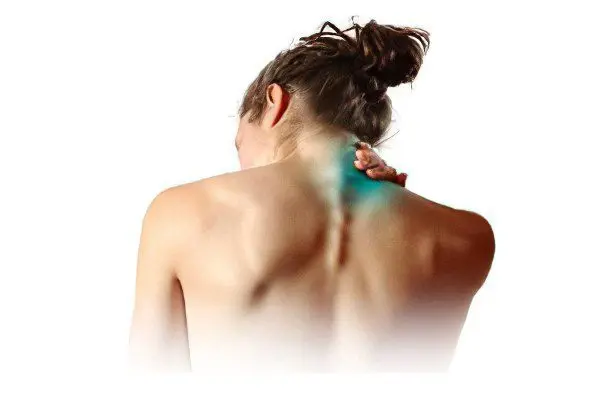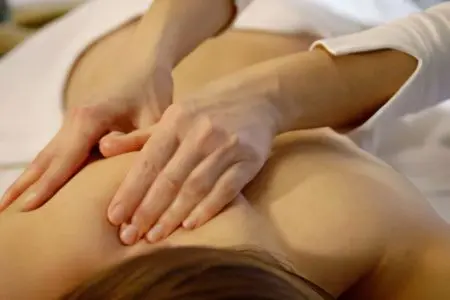Contents
cervical lordosis – this is a natural or pathological curvature of the spine with the reversal of its bulge in the cervical region anteriorly. Cervical lordosis, as a physiological bend, is present in every person. As for the pathological lordosis, it will be located in the same place, but its degree of bending will be different.
Pathology develops against the background of inflammatory processes of the spinal column, with contractures, congenital malformations, against the background of the presence of neoplasms, etc. The main manifestations of the disease are pain in the neck and problems with posture. As for the treatment, it can be both surgical and conservative.
Causes of cervical lordosis

The causes of cervical lordosis should be considered in parallel with the anatomical norm characteristic of the spinal column. It is known that the human spine is characterized by two physiological lordosis (cervical and lumbar) and two physiological kyphosis (thoracic and sacral). These bends can be found even in a baby, however, they will be very weakly expressed. As the child begins to grow up, stand up and walk, lordosis and kyphosis become more noticeable. But they will form over a long period of time. So, the spinal column completes its development by the age of 16-18. However, this does not mean that until this time, a child or adolescent will not be able to develop pathological cervical lordosis.
With this disease, there is an anterior displacement of the cervical vertebrae and a spindle-shaped divergence of their bodies. The bone structure of the anterior vertebrae is rarefied, and the intervertebral discs expand. At the same time, the vertebrae of the thoracic, and then the lumbar, begin to suffer, as their spinous processes gradually thicken and converge.
Especially dangerous is cervical lordosis, which manifests itself at an early and young age, since due to the imperfection of the musculoskeletal system, chest deformity occurs faster. This deformation, in turn, not only violates posture, but also affects the work of internal organs. The longer the child has cervical lordosis, the stronger the pathological changes in bones and organs will be. The formation of deformations of other parts of the body is also likely.
So, the causes of cervical lordosis can be identified as follows:
Diseases and pathological processes in the spine itself, which lead to the formation of primary cervical lordosis.
Muscular torsion dystonias, which force the patient to take pathological postures, can lead to the formation of a primary pathological bend in the cervical region. This disease is neurological in nature and is constantly progressing.
The danger is any injury to the spinal column, including birth injuries.
Congenital malformations of the spine.
Neoplasms in the cervical spine (tumors and hernias of the spine).
Inflammatory processes in the cervical spine.
Compensatory reactions of the spinal column, which appear in order to adapt to work in non-physiological conditions for it, lead to the development of secondary cervical lordosis. These include systemic diseases of the musculoskeletal system – osteoporosis, osteomyelitis, Bechterew’s disease, etc. Also, the cause of the disease can be bone tuberculosis, sciatica and severe scoliosis.
The presence of pathological lumbar lordosis and pathological kyphosis increases the risk of developing cervical lordosis. In 90% of cases, cervical kyphosis is a pathology acquired as a result of a violation of posture in childhood.
Risk factors are:
Forced prolonged stay of a person in the wrong position.
Physical inactivity, low physical activity, or improper exercise, as well as irrational passion for monotonous exercises.
Overweight.
Accelerated growth of the spinal column in childhood and adolescence.
Wrongly chosen clothes.
Improperly organized workplace for children and adults (discrepancy between furniture height and age of the owner, low illumination of the workplace, etc.).
Diseases of the internal organs, hearing and vision disorders.
As a rule, cervical lordosis, which occurs against the background of compensatory reactions of the spine, is mobile in nature and is able to completely disappear when provoking factors are eliminated. However, the longer the pathology exists, the worse the prognosis for recovery. In adult patients, fixed lordosis will persist even if the causes that caused it are eliminated.
Symptoms of cervical lordosis

Symptoms of cervical lordosis may be acute or may be mild.
The clinical picture of the pathology is characterized by:
The presence of pain in the cervical spine. They can radiate to the shoulder blades and shoulders. The pain is aggravated when you try to turn your head.
Pathological disorders of posture.
High fatigue.
The appearance of sharp pains when turning the head.
Headaches, tinnitus and frequent dizziness.
Numbness of the skin of the neck and face.
Decreased appetite.
Deterioration of working capacity, attention, memory.
Violation of sensitivity in the upper limbs by the type of numbness, the appearance of a feeling of crawling “goosebumps”.
Limitation of mobility of the neck and shoulder-scapular zone.
It is known that all the curves of the spine are in close relationship with each other, so an increase or decrease in the cervical bend will lead to a change in another curvature.
Along with this, the chest will begin to deform, and symptoms of physiological disorders from the internal organs will appear, including:
Shallow breathing, inability to take a deep breath;
Difficult work of the heart;
Oxygen starvation of the body with the development of anemia;
Stagnation of blood in the skull, pelvis, peritoneum, etc.
Therefore, it is so important to recognize the symptoms of the disease in time and seek medical help.
Diagnosis of cervical lordosis
Diagnosis of cervical lordosis is possible in the office of an orthopedist. To begin with, the doctor will carry out an external examination of the patient, assess his posture, perform palpation of the spine, measure the depth of the bend, and determine the most sensitive pain points. If the doctor suspects the presence of pathological cervical lordosis, then the patient is sent for an X-ray examination.
During x-rays, which are performed in two projections, the patient may be asked to tilt their head as far forward and then back as possible. This will make it possible to assess the degree of cervical lordosis. During the examination, a picture of the entire spine will be taken, which will give an idea of his condition.
Conducting studies such as MRI and CT help in establishing the cause of cervical lordosis, since even small tumors and hernias of the spine will be clearly visible on the pictures.
Treatment of cervical lordosis

Treatment of cervical lordosis will be most effective if the disease is not started, and the patient paid attention to the condition of his spinal column in time. Therapy implies an integrated approach and is built on the elimination of the cause that caused the pathology:
Drug treatment of cervical lordosis. Pain is relieved by taking non-steroidal anti-inflammatory drugs. This may be Ibuprofen, Diclofenac, or another drug from this group. If the pain in the neck is very intense, then intramuscular administration of Movalis is possible once a day. The full course of treatment is 1 days.
Vitamin complexes will help speed up recovery. Most often, with cervical lordosis, the drug Neuromultivit is prescribed, which includes vitamins of group B. With spasms of the muscles of the neck, muscle relaxants are indicated, for example, the drug Mydocalm.
Physiotherapeutic treatment of cervical lordosis. Physiotherapeutic techniques are aimed at improving the nutrition of tissues, at increasing the contractile activity of muscles in the problem area. They also have a general strengthening effect. Calcium and phosphorus electrophoresis, ultraviolet irradiation, and inductometry are widely used.
Performing a complex of physiotherapy exercises. Exercise therapy plays a leading role in the treatment of cervical lordosis. They are aimed at the formation of stable connections between the muscles of the back and the spinal column, contribute to the creation of a muscular corset that will securely hold the spine in the correct position. Even if the disease cannot be completely eliminated, then regular exercise will make it possible to stop its progression. Complexes of physiotherapy exercises are compiled on an individual basis, depending on the degree of curvature of the spine, on the age of the patient and his state of health in general.
Rational nutrition and daily routine. It is important that the menu of patients is balanced and enriched with mineral salts and vitamins. It is from food that useful substances are absorbed by the body as much as possible, compared with synthetic vitamins. The patient should be fully rested. Children should purchase an orthopedic mattress and pillow. It is important that a person constantly monitors his posture, both during rest and during work. Proper organization of the workplace is of no small importance.
Massage. Massage is a mandatory component of the complex treatment of people with cervical lordosis. A general massage of the back and neck is used, it should only be performed by a professional massage therapist. With its help, it will be possible to improve lymphatic outflow, increase blood supply, strengthen the muscles of the neck and back, bring them into tone. The general well-being of the patient improves.
Surgical intervention. Surgical elimination of the pathology is possible if the patient’s primary cervical lordosis was provoked by a hernia, tumor, or trauma. The method of eliminating the pathology depends on its nature. To reduce pain, it is possible to wear corsets and bandages, but, as a rule, they do not have a therapeutic effect. It is possible to undergo sanatorium treatment at specialized resorts. Patients should choose sanatoriums that offer mineral baths, balneotherapy, thalassotherapy.
It is important to remember that timely treatment of cervical lordosis will not allow the development of various disorders of the internal organs. In addition, the advanced stages of the disease can negatively affect intracranial pressure, the work of the upper limbs, the vision and hearing of a person, as well as his cognitive abilities.









